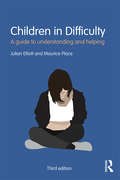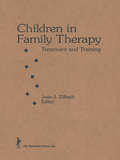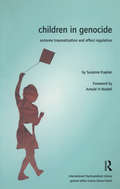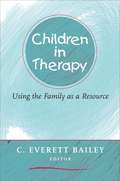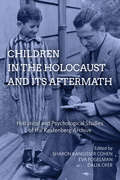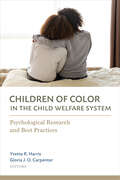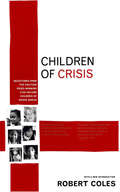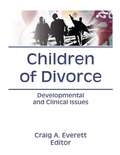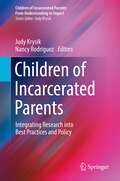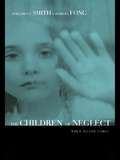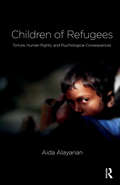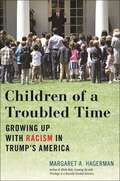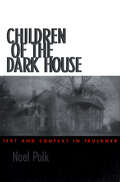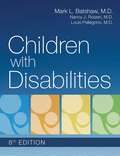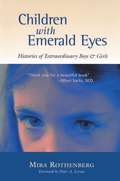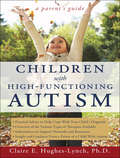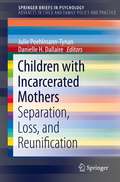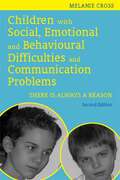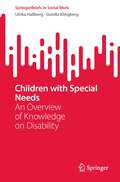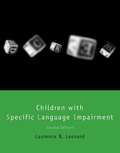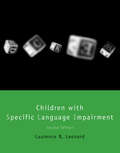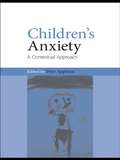- Table View
- List View
Children in Difficulty: A guide to understanding and helping
by Julian Elliott Maurice PlaceWritten by two leading experts in the field, this welcome third edition of Children in Difficulty: A guide to understanding and helping discusses some of the most common, yet incapacitating, difficulties that are frequently encountered by young children and adolescents. This includes such topics as: ADHD disruptiveness and challenging behaviour in schools and classrooms dyslexia and reading disability eating disorders oppositional defiance, conduct and attachment disorders childhood depression school refusal developmental coordination disorder (dyspraxia) less common mental health problems, such as bipolar disorder and obsessive compulsive disorder. traumatic and stressful situations drug and solvent abuse. The third edition of this book includes brand new insights from the fields of genetics and neuroscience and ensures claims for the effectiveness of specific interventions are supported by rigorous, scientific evidence. By drawing upon high level scientific and clinical knowledge and distilling it in a way that is accessible to professionals from a range of child care disciplines, this book will be of significant value to those working in education, health or social care, and anyone who needs to be able to recognise and help children in difficulty.
Children in Family Therapy: Treatment and Training
by Joan J ZilbachHere is one of the few books that focuses explicitly on including children in family therapy sessions. The contributors to this enlightening volume are seasoned family therapists of various theoretical perspectives who work in a variety of settings and include children of all ages in their therapy practices. Recognizing that many practicing therapists are not comfortable including children, they address the treatment and training issues and provide extensive case studies and fascinating background material on their own early involvement in the practice. Children in Family Therapy will be extremely valuable to family therapists of all levels of experience. For the veterans, the cases that are different in approach from their own will be particularly informative. Less experienced therapists will find here a basic introduction and a clear description of the range of clinical practice in family therapy.
Children in Genocide: Extreme Traumatization and Affect Regulation (Ipa: The International Psychoanalysis Library)
by Suzanne KaplanThis book deals with affects and memories from extreme traumatization of Jewish survivors, who were children themselves during the Holocaust, and teenagers who survived the genocide in Rwanda in 1994, presenting an illustration of how complex affect regulating is for traumatized individuals.
Children in Mind: Their mental health in today’s world and what we can do to help them
by Jenny PerkelA psychologist’s guide for parents, care-givers and health care practitioners to the emotional challenges facing children and their parents todayCurrent research shows that certain childhood mental disorders are diagnosed more frequently today than in previous generations. Many of today’s children and teenagers are more unhappy, anxious and distressed than young people used to be. In this highly informative book, child psychologist Jenny Perkel explores in depth why this might be so, highlighting what modern-day South African children and adolescents are experiencing and the environment in which they are being raised.Children in Mind presents a broad range of up-to-date findings from psychological, neurobiological, genetic, psychiatric, sociological and epidemiological research related to the diagnosis and treatment of children’s mental health problems. Theoretically informed but not theoretically dense, the book cites both local and international studies to increase awareness and understanding of children’s mental health.Perkel discusses a broad spectrum of issues faced by today’s children and adolescents: the Covid-19 pandemic, the influence of electronic media, diverse family structures, stress and trauma, and difficult socio-economic circumstances. While offering no easy answers or formulaic solutions to the problems of troubled children, she shows how to think about children’s mental well-being in today’s South Africa.Children in Mind is an invaluable resource for all those who work with troubled children and adolescents: psychologists, social workers, counsellors, educators and parents. The author’s informed and compassionate approach will help equip professionals and parents to help young people navigate complex issues and make adjustments in their behavior in order to live more balanced and happier lives.
Children in Therapy: Using the Family as a Resource
by C. Everett BaileyThe editor's purpose in editing the book Children in Therapy was to provide a resource for clinicians to help them identify how to assess the family and intervene in the dynamics within the family system that negatively affect children and significantly contribute to their disorders.
Children in the Holocaust and its Aftermath: Historical and Psychological Studies of the Kestenberg Archive
by Eva Fogelman Sharon Kangisser Cohen Dalia OferThe testimonies of individuals who survived the Holocaust as children pose distinct emotional and intellectual challenges for researchers: as now-adult interviewees recall profound childhood experiences of suffering and persecution, they also invoke their own historical awareness and memories of their postwar lives, requiring readers to follow simultaneous, disparate narratives. This interdisciplinary volume brings together historians, psychologists, and other scholars to explore child survivors' accounts. With a central focus on the Kestenberg Holocaust Child Survivor Archive's over 1,500 testimonies, it not only enlarges our understanding of the Holocaust empirically but illuminates the methodological, theoretical, and institutional dimensions of this unique form of historical record.
Children of Alcoholism: The Struggle for Self and Intimacy in Adult Life
by Barbara L. WoodIn this sensitive and richly rewarding book Barbara L. Wood, a clinician with many years' experience working with adult children of the chemically dependent, gives clinicians informed and practical advice on how to treat the damaged self of these individuals. She offers strategies for intervention, along with step-by-step principles that tell the therapist how best to create an environment to help patients.
Children of Color in the Child Welfare System: Psychological Research and Best Practices
by Yvette R. Harris Gloria J. O. CarpenterThis book offers mental health professionals insights and recommendations for supporting children of color in the child welfare system. Race plays a pivotal role in the experiences of children in the child welfare system. Children of color are more likely to enter the system, stay in the system longer, and receive fewer services while they are in it. As a result, they are more likely to face a decline in their immediate and long-term academic and educational progress, more likely to enter the juvenile justice system, and less likely to be satisfied with counseling and other support services they receive while in out-of-home placements. This book offers the crucial insights and key recommendations that mental health professionals need to support children of color in the child welfare system. By understanding the challenges that children of color face in the system, as well as best practices for supporting them, professionals in the child welfare system can improve outcomes. The book will be an essential resource for researchers, counselors and clinicians who work in the child welfare system, as well as those designing interventions to help children and their families.
Children of Crisis: Selections from the Pulitzer Prize-Winning Five-Volume Children of Crisis Series
by Robert ColesIn the 1950s Robert Coles began studying, living among, and, above all, listening to American children. The results of his efforts--revealed in five volumes published between 1967 and 1977--constitute one of the most searching and vigorous social studies ever undertaken by one person in the United States. Here, heard often in their own voices, are America's "children of crisis": African American children caught in the throes of the South's racial integration; The children of impoverished migrant workers in Appalachia; Children whose families were transformed by the migration from South to North, from rural to urban communities; Latino, Native American, and Eskimo children in the poorest communities of the American West; The children of America's wealthiest families confronting the burden of their own privilege. This volume restores to print a masterwork of psychological and sociological inquiry--a book that, in its focus on how children learn and develop in the face of rapid change and social upheaval, speaks directly and pointedly to our own times. Robert Coles is a professor of psychiatry and medical humanities at the Harvard Medical School, a research psychiatrist for the Harvard University Health Services, and the James Agee Professor of Social Ethics at Harvard College.
Children of Divorce: Developmental and Clinical Issues
by Craig EverettGain new understanding of the role that the children of divorce play within their own family systems. Unlike most other literature on the subject, Children of Divorce studies--both empirically and clinically--the role of the children within the dysfunctional pattern of the dissolving family system. The unique and insightful perspectives in this volume equip practitioners and clinicians with the skills to help children cope with the pain and the adjustments they experience during and after a divorce. Experts in the marriage and family field explore the developmental, structural, and interactional issues for the benefit of all professionals seeking to more effectively understand and treat the children who are so adversely affected by divorce.
Children of Divorce: Stories of Loss and Growth, Second Edition
by Mark A. Fine John H. HarveyFeaturing excerpts of essays collected from over one thousand young adults while in the throes of divorce, this book paints a picture of the pain and the hope shown by the storytellers. By framing the narratives with an analysis of the most recent divorce literature, the authors provide readers with a greater and more vivid understanding of the effects of divorce. Challenging the contention that most children will be irretrievably hurt by their parents' divorce, some stories clearly demonstrate the strength and resilience many have learned in dealing with a divorce in the family. Emphasis is placed on how hope about the possibilities of having close relationships - as well as a willingness to create stronger families in their own lives - represent abiding motivations in this sample of young people. The authors hope that the use of the raw input of respondents will make the experiences more realistic and ultimately help people deal with major loss events in their lives. Highlights of the new edition include: A new chapter (7) that demonstrates the messiness of divorce (infidelity, dysfunctional interactions, multiple marriages/relationships, and the financial expense), the fading stigma of divorce, the latest divorce rates, the increased average age of first time marriages, and the recent hook-up phenomenon wherein young people are showing a reluctance to commitment Updated throughout with the most current demographic data, new findings from the top researchers in the field, and the latest intervention programs A review of the Divorce Variability and Fluidity Model (DVFM) that helps predict variability in adjusting to divorce More suggestions to help children adapt to divorce, including material on parenting education classes and mediation as a method for easing the process A list of readings and suggested websites for further review More tables and graphs to summarize key concepts. An ideal supplement for courses on divorce, family studies, close relationships, and loss and trauma taught in human development and family studies, and clinical, counseling, and social psychology, as well as communication, social work, and sociology, these engaging stories also appeal to practitioners and those interested in the effects of divorce in general.
Children of Incarcerated Parents: Integrating Research into Best Practices and Policy (Children of Incarcerated Parents: From Understanding to Impact)
by Nancy Rodriguez Judy KrysikThis book presents multidimensional knowledge on children of incarcerated parents using Bronfenbrenner’s ecological theory as an organizing framework. It examines the extent to which different levels of the environment are supportive (i.e., leading to resilience) and stress-producing (i.e., contributing to risk). The volume explores four levels of the environment – microsystem, mesosystem, exosystem, and macrosystem – with specific theories and paradigms woven into the inquiry at each. At the level of child and family, it discusses the factors that influence resilience and risk in children from gestation through young adulthood; at the community level, it addresses risk and resilience in the interactions between children and families and the various systems with which they interact (e.g., child welfare). Key areas of coverage include: · A description of the factors that influence the quality of programming for children and their families. · A critical analysis of state and national policies that affect which individuals receive, or fail to receive, specific services. · An overview and evaluation of the state of knowledge and implications for research and practice to improve outcomes for children of incarcerated parents. · An organizing framework to help researchers identify gaps in the existing knowledge base and distills and organizes evidence-based information for practitioners. Children of Incarcerated Parents is an essential resource for researchers, professors, and graduate students as well as practitioners, therapists, and other professionals in child and school psychology, family studies, public health, and all interrelated disciplines, including developmental psychology, criminal justice, social work, educational policy and politics.
Children of Neglect: When No One Cares
by Margaret Smith Rowena FongThis book contains a comprehensive review of the current state of child neglect. Included are statistics regarding incidence and lethality, definitional issues, etiological theory, history of and current policy, and current interventions. As child neglect is often linked with structural issues, the book also examines the relationship of child neglect to poverty, substance abuse and culture.
Children of Refugees: Torture, Human Rights, and Psychological Consequences
by Aida AlayarianThere is a wide gap between the psychological needs of the children of refugees and the services provided. Refugees' home countries, cultures, and social make-up are widely diversified, and their needs cannot be readily consolidated. This diversity of interest and need goes unacknowledged by the service-providers who may treat them as a single, homogenous group. Some refugees' needs are exaggerated, while others are ignored. This approach often ignores the justifiable and legitimate interest of refugees' psychological wellbeing. Many children of refugees may struggle with questions of race, ethnicity, language barriers, and other socio-political and economic issues that can influence their mental health and psychological wellbeing. Preoccupations of the child's emotions with those issues therefore have effects on child personality formations. Apart from having an overview of the relevant processes involved in therapeutic work and possible challenges therein, it is also important for the therapist to have an overview of the child's situation in the past and any current issues, which this book provides.
Children of a Troubled Time: Growing Up with Racism in Trump's America
by Margaret A. HagermanProvides a child’s-eye perspective on how the culture wars are playing out in our nation’s schoolsKids are at the center of today’s “culture wars”—pundits, politicians, and parents alike are debating which books they should be allowed to read, which version of history they should learn in school, and what decisions they can make about their own bodies. And yet, no one asks kids what they think about these issues.In Children of a Troubled Time, award-winning sociologist Margaret A. Hagerman amplifies the voices of children who grew up during Trump’s presidency and explores how they learn about race in America today. Hagerman interviewed nearly fifty children between the ages of ten to thirteen in two dramatically different political landscapes: Mississippi and Massachusetts. Hagerman interviewed kids who identified as conservative and liberal in both places as well as kids from different racial groups. She discovered remarkably similar patterns in the ideas expressed by these children. Racism, she asserts, is not just a local or regional phenomenon: it is a broad American project affecting childhoods across the country.In Hagerman’s emotionally compelling interviews, children describe what it is like to come of age during years of deep political and racial divide, and how being a kid during the Trump era shaped their views on racism, democracy, and America as a whole. Children’s racialized emotions are also central to this book: disgust and discomfort, fear and solidarity, dominance and apathy.As administrators, teachers, and parents struggle to help children make sense of our racially and politically polarized nation, Hagerman offers concrete examples of the kinds of interventions necessary to help kids learn how to become members of a multi-racial democracy and to avoid the development of far-right thinking in the white youth of today. Children of a Troubled Time expands our understanding of how the rising generation grapples with the complexities of racism and raises critical questions about the future of American society.
Children of the Dark House: Text and Context in Faulkner
by Noel PolkThis book by a major scholar of William Faulkner’s writings collects choice selections of his Faulkner criticism from the past fifteen years. Its publication underscores the significance of his indispensable work in Faulkner studies, both in criticism and in the editing of Faulkner’s texts. Here, Polk’s focus is mainly upon the context of Freudian themes, expressly in the works written between 1927 and 1932, the period in which Faulkner wrote and ultimately revised Sanctuary, a novel to which Polk has given concentrated study during his distinguished career. He has connected the literature with the life in a way not achieved in previous criticism. Although other critics, notably John T. Irwin and Andre Bleikasten, have explored Oedipal themes, neither perceived them as operating so completely at the center of Faulkner’s work as Polk does in these essays.
Children with Disabilities
by Mark Batshaw Nancy Roizen Louis PellegrinoExplore what's new in the new edition! <P><P>Trusted for four decades by university faculty and relied on by thousands of professionals from diverse fields, Children with Disabilities is the gold-standard text on working effectively with children and families. Now this authoritative resource is in its eighth edition, enhanced with new chapters on critical topics, the latest evidence-based practices, updated instructor materials, and guidance on working with a wide range of professionals to address every aspect of child health and well-being. <P><P>Spearheaded by senior editor Mark Batshaw, M.D., Chief Academic Officer at Children's National Health System, this new edition is an unparalleled compendium of information about developmental, clinical, family, education, and intervention issues, from birth through adolescence. Every chapter has been meticulously peer-reviewed, and content has been updated throughout to reflect important new research and developments in diverse fields. Comprehensive coverage of contemporary issues makes this volume an indispensable reference for practicing professionals, and the student-friendly features and multimedia instructor materials make it the ultimate textbook for courses on disability. <P><P>A treasury of essential knowledge from a who's who of today's leading experts and innovators, Children with Disabilities is a cornerstone resource that professionals will use year after year to support their important work and ensure that every child and family thrives.
Children with Emerald Eyes: Histories of Extraordinary Boys & Girls
by Mira Rothenberg Peter A. LevineMira Rothenberg pioneered both the clinical distinction and treatment protocol for autistic and severely disturbed children as separate from those for the mentally retarded. Winner of a Woman of the Year award from the New York City Chamber of Commerce and the National Organization for Mentally Ill Children, she writes here eloquently of a lifetime of taking on seemingly hopeless cases and bringing these children, through painstaking therapy and love, back into the world. Children with Emerald Eyes includes case histories ranging from incarcerated teenagers to a profoundly autistic six-year-old, told with the same power and sympathy Rothenberg used in her practice.
Children with High Functioning Autism: A Parent's Guide
by Claire E. Hughes-Lynch"Children With High-Functioning Autism: A Parent's Guide" offers parents the information needed to help them cope with their child's autism and to navigate the path as they first perceive differences, seek assistance and treatment, and help their child develop into his or her full potential.
Children with Incarcerated Mothers: Separation, Loss, and Reunification (SpringerBriefs in Psychology)
by Julie Poehlmann-Tynan Danielle H. DallaireThis Brief focuses on children with incarcerated mothers, a growing and vulnerable population. It presents five empirical studies, along with an introduction and summary chapter. The five empirical chapters examine new qualitative and quantitative data on: Typical occurrences when pregnant women give birth during incarceration in contrast with the benefits of a prison doula program for mothers and newborns. A mother’s criminal justice involvement for substance abuse crimes and its effects on children’s protective services involvement and foster care placement. How children cope with separation from their mothers because of their incarceration and how that separation continues to affect children's lives following family reunification. Differences in recidivism trajectories between mothers and nonmothers during the 10 years following release from incarceration. Alternatives to incarceration for women in residential drug treatment and how community supervision mandates can affect, contribute to, or extend mother-child separation. The final chapter integrates the information from the empirical studies and summarizes implications for policy and practice. Children with Incarcerated Mothers is an essential resource for policy makers and related professionals, graduate students, and researchers in child and school psychology, family studies, public health, social work, law/criminal justice, and sociology.
Children with Social, Emotional and Behavioural Difficulties and Communication Problems
by Melanie CrossChildren and young people with social, emotional and behavioural difficulties (SEBD) are far more likely to have communication problems than their peers, yet these problems are under-recognised, under-researched, and most importantly, often unaddressed. Melanie Cross considers the reasons why behavioural and communication difficulties so often occur together, and examines the social, educational and mental health implications of this. She shows that improving the communication skills of children and young people with SEBD can contribute to better outcomes, and that speech and language therapy is an important, yet often absent, service for this group. She provides practical guidelines for assessing communication, as well as useful strategies to help children and young people with SEBD to develop their communication skills. This second edition also contains information on unidentified and unmet communication needs in vulnerable young people, including young offenders and those at risk of social exclusion. This book will be an invaluable resource for speech and language therapists, social workers, teachers and other professionals working with children with emotional, behavioural and communication difficulties.
Children with Special Needs: An Overview of Knowledge on Disability (SpringerBriefs in Social Work)
by Ulrika Hallberg Gunilla KlingbergThere can be a lack of understanding of the vulnerable situation of children with disabilities and their families, even among professional caregivers whose mission is to protect the health and wellbeing of these children. Their respectful treatment should include knowledge, empathy, humanity, and an open and sympathetic dialogue. This book provides an overview of knowledge and literature review of children and adolescents with special care needs that contribute to the respect and understanding of children with disabilities and their families. It also explains possible reasons for different outcomes in research studies and why there is a lack of knowledge in some areas concerning these children. Research on children with disabilities is considerable but often can be difficult to access on many levels, which means it does not always benefit those who need this knowledge. This compact book addresses this by presenting the international research in the field in an understandable way for people who work with children with disabilities and their families. The authors provide a broad picture of the background, reality of life, opportunities for professional help and support, as well as outlook of these children and families. Among the topics covered:The Health and Well-being of Children with DisabilitiesThe Health and Well-being of RelativesOccupationOn the Road to AdulthoodChildren with Special Needs: An Overview of Knowledge on Disability is pertinent reading for students in all areas of health care (including nursing and psychology), social work, sociology, and education aimed at children and young people. The text also would be of interest to those who practice in these areas and/or encounter children with disabilities in their daily work.
Children with Specific Language Impairment
by Laurence B. LeonardChildren with specific language impairment (SLI) show a significant deficit in spoken language that cannot be attributed to neurological damage, hearing impairment, or intellectual disability. More prevalent than autism and at least as prevalent as dyslexia, SLI affects approximately seven percent of all children; it is longstanding, with adverse effects on academic, social, and (eventually) economic standing. The first edition of this work established Children with Specific Language Impairment as the landmark reference on this condition, considering not only the disorder's history, possible origins, and treatment but also what SLI might tell us about language organization and development in general. This second edition offers a complete update of the earlier volume. Much of the second edition is completely new, reflecting findings and interpretations based on the hundreds of studies that have appeared since the publication of the first edition in 1997. Topics include linguistic details (descriptive and theoretical), word and sentence processing findings, genetics, neurobiology, treatment, and comparisons to such conditions as autism spectrum disorders, ADHD, and dyslexia. The book covers SLI in children who speak a wide range of languages, and, although the emphasis is on children, it also includes studies of adults who were diagnosed with SLI as children or are the parents of children with SLI. Written by a leading scholar in the field, Children with Specific Language Impairment offers the most comprehensive, balanced, and unified treatment of SLI available.
Children with Specific Language Impairment (Language, Speech, and Communication)
by Laurence B. LeonardThe landmark reference in the field, completely updated: a comprehensive treatment of a disorder that is more prevalent than autism. Children with specific language impairment (SLI) show a significant deficit in spoken language that cannot be attributed to neurological damage, hearing impairment, or intellectual disability. More prevalent than autism and at least as prevalent as dyslexia, SLI affects approximately seven percent of all children; it is longstanding, with adverse effects on academic, social, and (eventually) economic standing. The first edition of this work established Children with Specific Language Impairment as the landmark reference on this condition, considering not only the disorder's history, possible origins, and treatment but also what SLI might tell us about language organization and development in general. This second edition offers a complete update of the earlier volume.Much of the second edition is completely new, reflecting findings and interpretations based on the hundreds of studies that have appeared since the publication of the first edition in 1997. Topics include linguistic details (descriptive and theoretical), word and sentence processing findings, genetics, neurobiology, treatment, and comparisons to such conditions as autism spectrum disorders, ADHD, and dyslexia. The book covers SLI in children who speak a wide range of languages, and, although the emphasis is on children, it also includes studies of adults who were diagnosed with SLI as children or are the parents of children with SLI.Written by a leading scholar in the field, Children with Specific Language Impairment offers the most comprehensive, balanced, and unified treatment of SLI available.
Children's Anxiety: A Contextual Approach
by Peter AppletonChildren’s Anxiety: A Contextual Approach provides an introduction to anxiety in children and teenagers, emphasising the importance of understanding the life circumstances of young people. The book provides an up-to-date account of research on the developmental, familial and social context of child anxiety, along with nine vibrant and detailed case studies illustrating the ways in which young people can be helped to deal with serious and complex anxiety problems. In order to begin to understand complex anxiety within children’s life circumstances Part One of the book provides the reader with a developmental framework for thinking about children’s anxiety. Part Two then presents nine in depth case studies, organised not by the type or nature of anxiety but by the context within which problematic anxiety can occur. Part Three acts as a summary of the key points emerging from the clinical case studies. This book will be essential reading for those working and training in the specialist field of child mental health, as well as community and hospital professionals working with children and young people, including teachers, doctors, social workers and nurses.
